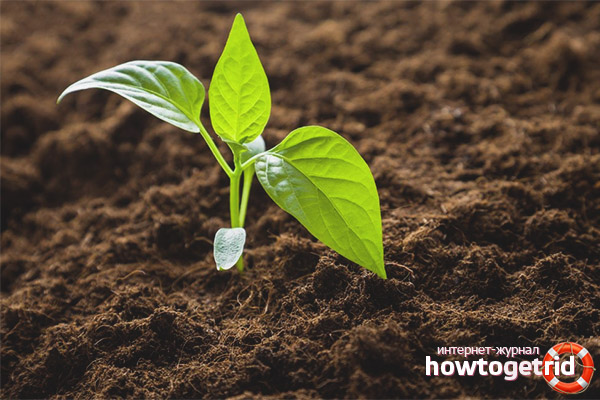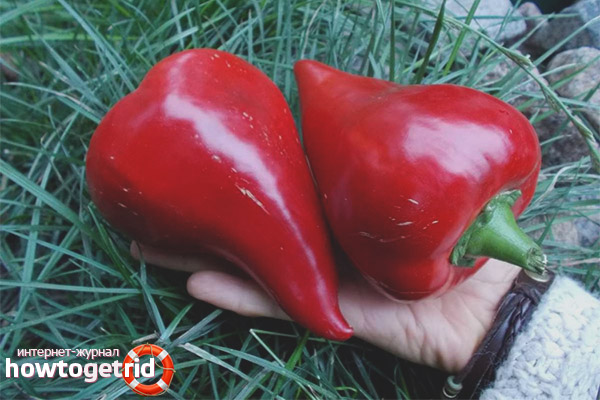The content of the article
Lesya pepper is an early, very productive and unpretentious variety. Fruits are slightly elongated, drop-shaped. In the seed chambers, a small amount of seeds ripen. A variety of universal purpose. Bushes are low, sprawling, require the formation, removal of stepsons. From one bush per season, you can collect up to 30 fruits. Due to the sparseness of the bushes, it is not recommended to plant seedlings close to each other, no more than 2-3 plants can be placed in one square place.
You can get a good crop of Lesya pepper by growing previously strong, healthy seedlings.
How to grow pepper seedlings yourself
Seeds before planting should be disinfected in a weak solution of potassium permanganate. Experienced gardeners recommend treating the seed with a growth stimulator, for example, heteroauxin.
- To grow good seedlings you need a quality soil mixture. It is not enough just to take soil from the street, you need to prepare the soil yourself or purchase it in a specialized store.
- Pepper does not tolerate acidic soils, so choose a soil with a pH of about 7. The earth should be structured, light, porous and more fertile. Ideally, black pepper or sandy loam soil is suitable for growing seedlings of bell pepper.
- If you want to make the soil mixture with your own hands, take the rotted compost, humus, coarse river sand, garden soil and some ash.
- Seeds close up to a depth of 1.5-2 cm, after sowing watered by spraying with warm water. A container of seeds is placed in a warm place and covered with glass. At the first stages of germination, light is not required, but as soon as you notice the light loops of the first shoots, urgently transfer the containers closer to the light.
- Some novice summer residents try to sow pepper in February-January, hoping to get early production. They are very wrong. The fact is that in February, late January, and in early March, daylight hours are not long enough. Young shoots of bell pepper are sorely lacking in the energy of the sun. Little seedlings suffer from a lack of sunlight, it stretches out, is yellower, begins to suffer from a lack of nutrition, caused by a failure of the photosynthesis process.
- Keep in mind that pepper seedlings must be highlighted with phytolamps in the morning and evening hours.
- At the age of three weeks, feed the young pepper with a complex fertilizer or urea solution. When the first 4 leaves appear, dive into separate pots or cups. If you have little space, you can grow seedlings in cassettes, cells or peat tablets.
- The dive procedure is required. Neglecting it, you doom the plants to suffering. Seedlings, which continue to grow for a long time in one tank, become thin, elongated, yellow, non-viable. If you plant it in the open ground, it will be sick for a long time, it will not tolerate a transplant, it will yield a very meager crop, or even die.
Do not forget that bell pepper is a heat-loving plant. It does not tolerate lowering temperatures to +5 degrees. Plants freeze, stop growing, the root system ceases to fulfill its functions, for some time such seedlings will stand still and then fade. Also, pepper does not tolerate drafts.
Planting seedlings in greenhouses or open ground

When planting seedlings at a permanent place of cultivation, plants must be taken out of the pots very carefully, together with a lump of earth. The fact is that the small roots of pepper are poorly restored, not at all like the roots of tomatoes.
- It is recommended to add nitroammophoska, a little wood ash to the planting pits. Before disembarkation, the well is abundantly watered with warm water. Do not dig the plant below the cotyledon leaves into the soil.
- Some novice gardeners tend to plant seedlings as deep as possible. It is not right. The fact is that the formation of additional roots, which will go from a stem immersed in a layer of soil, will require considerable time and resources. At the same time, the plant will suspend its growth and development. It will bloom a couple of weeks later and, accordingly, later bring a harvest.
- Do not try to plant seedlings too early. Wait for steady warm weather. It is best to plant pepper in the ground in late May, or even early June. After planting, planting can be protected for the first time with film, non-woven material or fiber. Shelter will save tender seedlings from the bright rays of the sun and gusts of wind.
- The first top dressing can be done when the seedlings take root, 2 weeks after planting.
- Pepper is very responsive to organics. Prepare an herbal slurry to water the bushes at the root. For its preparation, you can use any grass, garden weeds, dandelions and other plants. Herbal material is placed in a container, filled with water and kept for 3 weeks. After the fermentation process is completed, the infusion is filtered, diluted with warm water and the bell pepper is watered at the root, in the pits or furrows. It is noted that after such herbal fertilizers, the yield and quality of the fruit improves.
- If you grow Les's pepper in a greenhouse, keep in mind that at temperatures above 35 degrees and low humidity, the pollen becomes sterile, pollination and fertilization ceases, the fruits do not set. Therefore, take care of ventilating the greenhouses, arrange window leaves.
You can re-grow this culture in the same place no earlier than three years later. Good precursors for pepper are onions, peas, cabbage.
Harvest fruits in the stage of technical ripeness. Lesia pepper ripens in waves, fruiting lasts until mid-October.
Video: Lesya's pepper










Submit